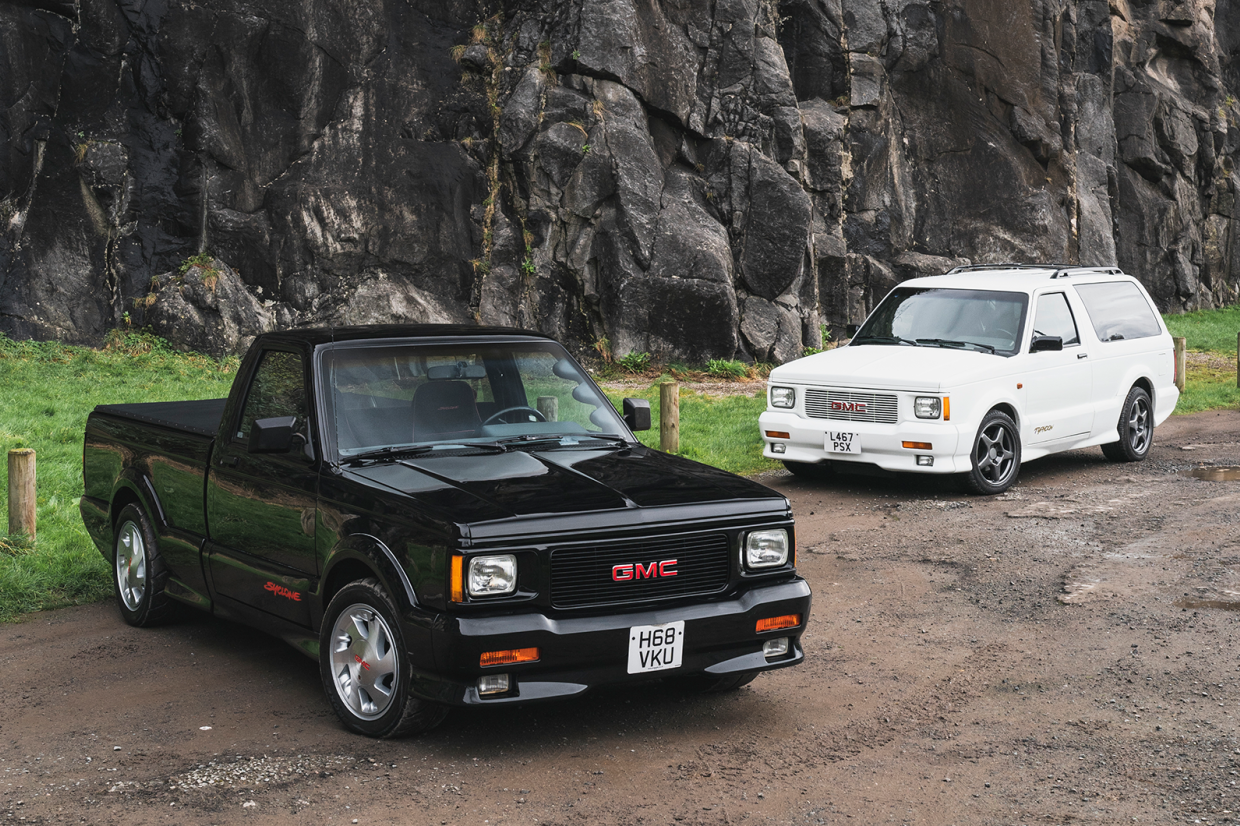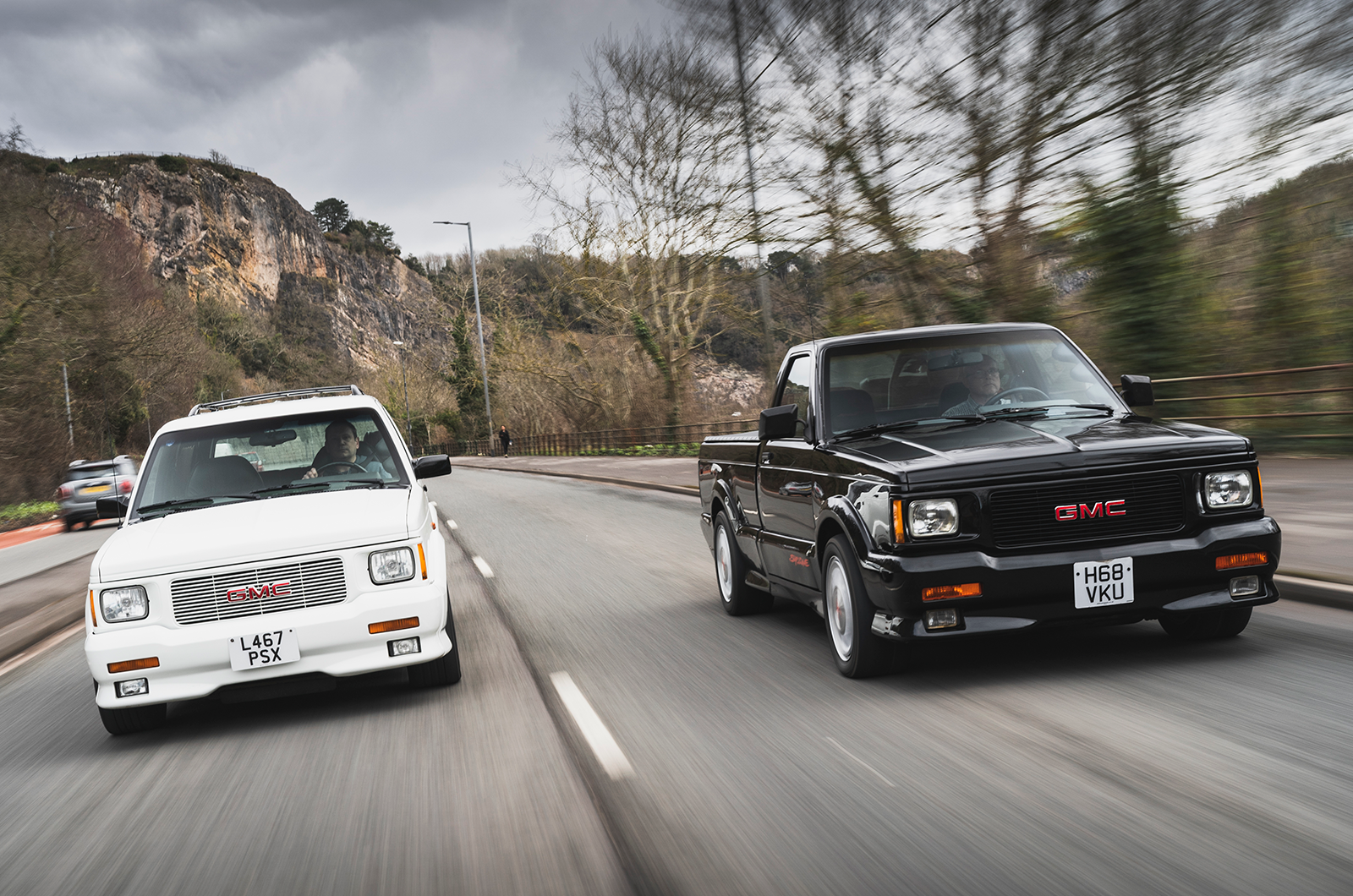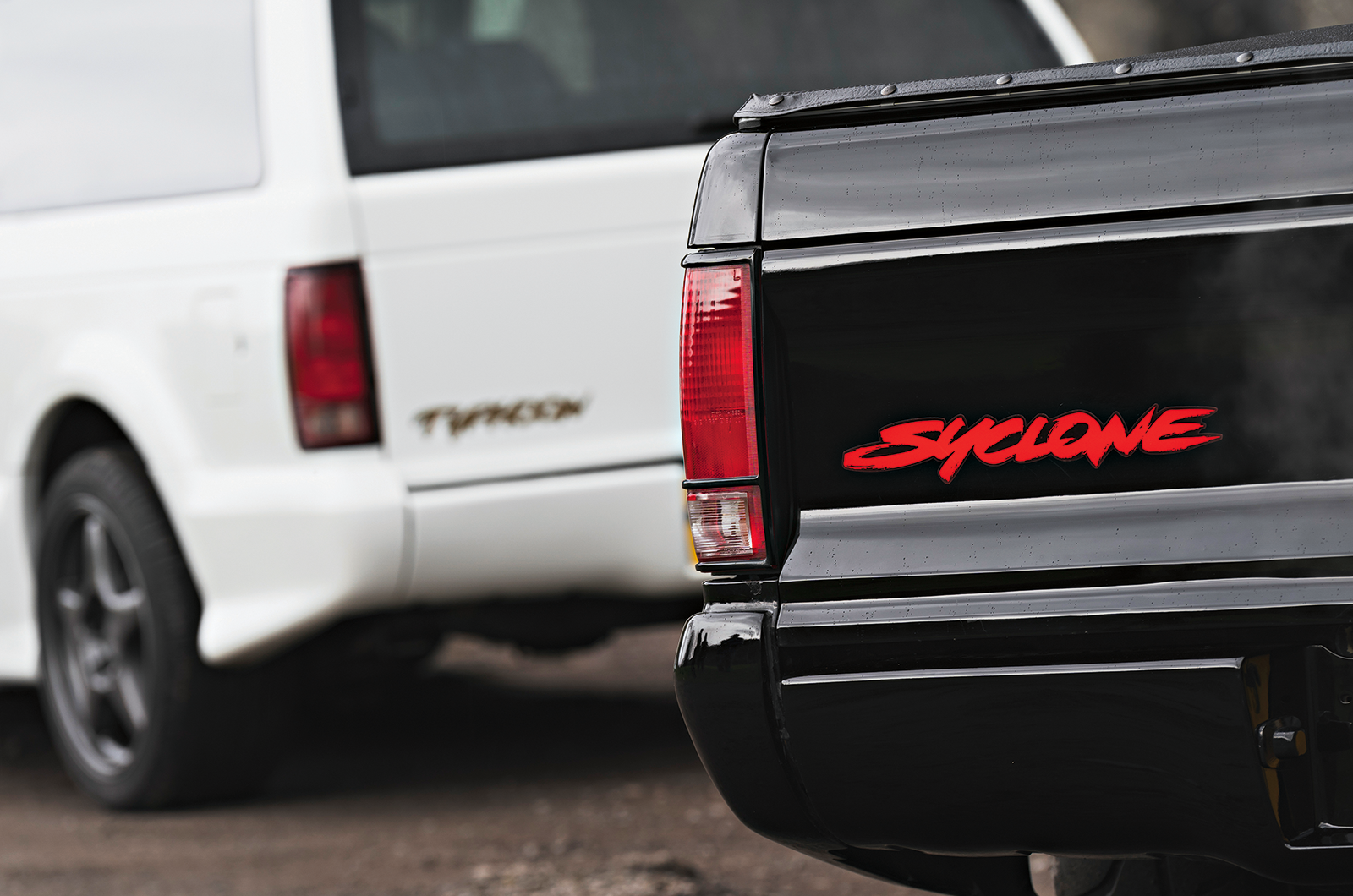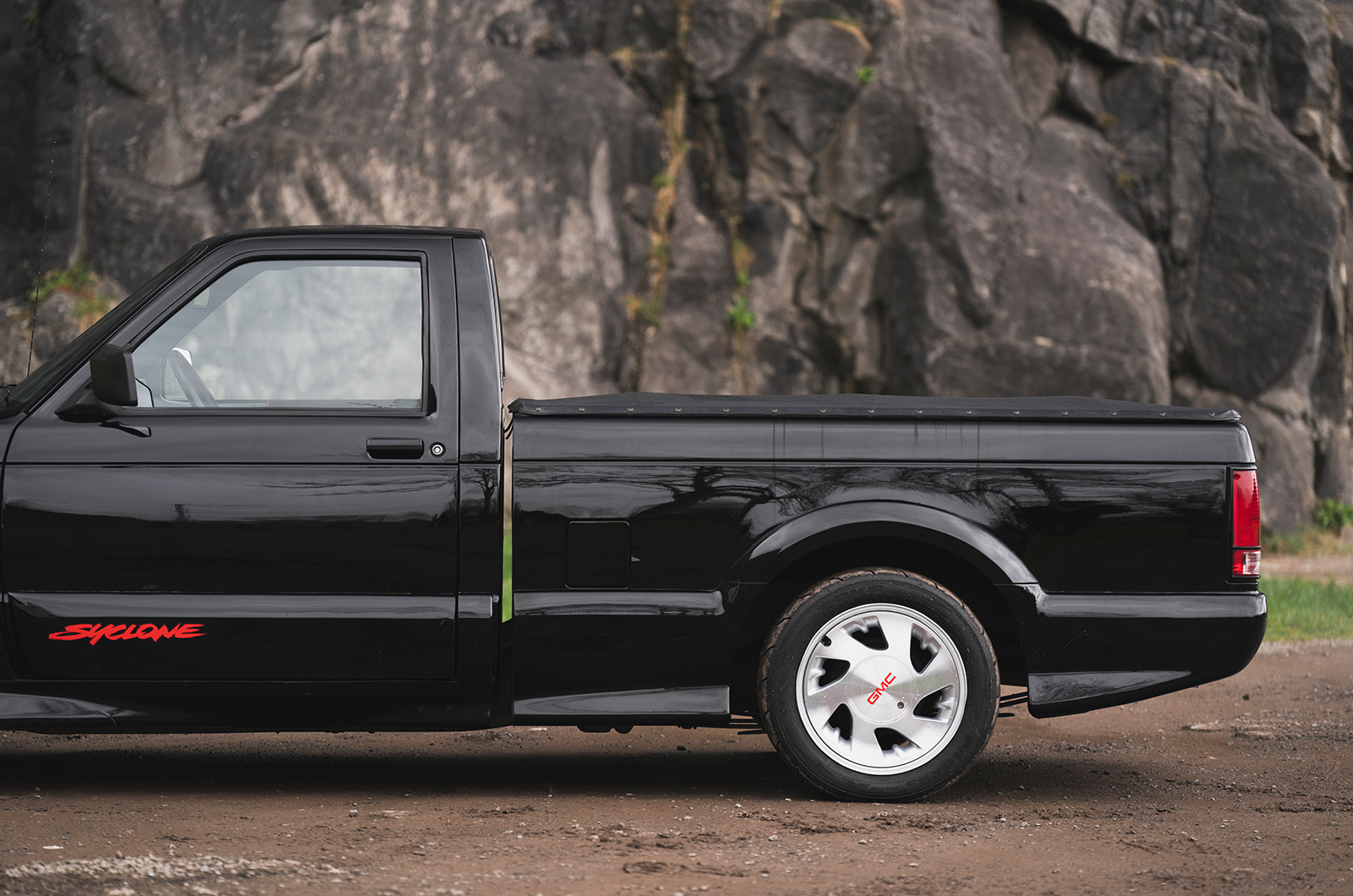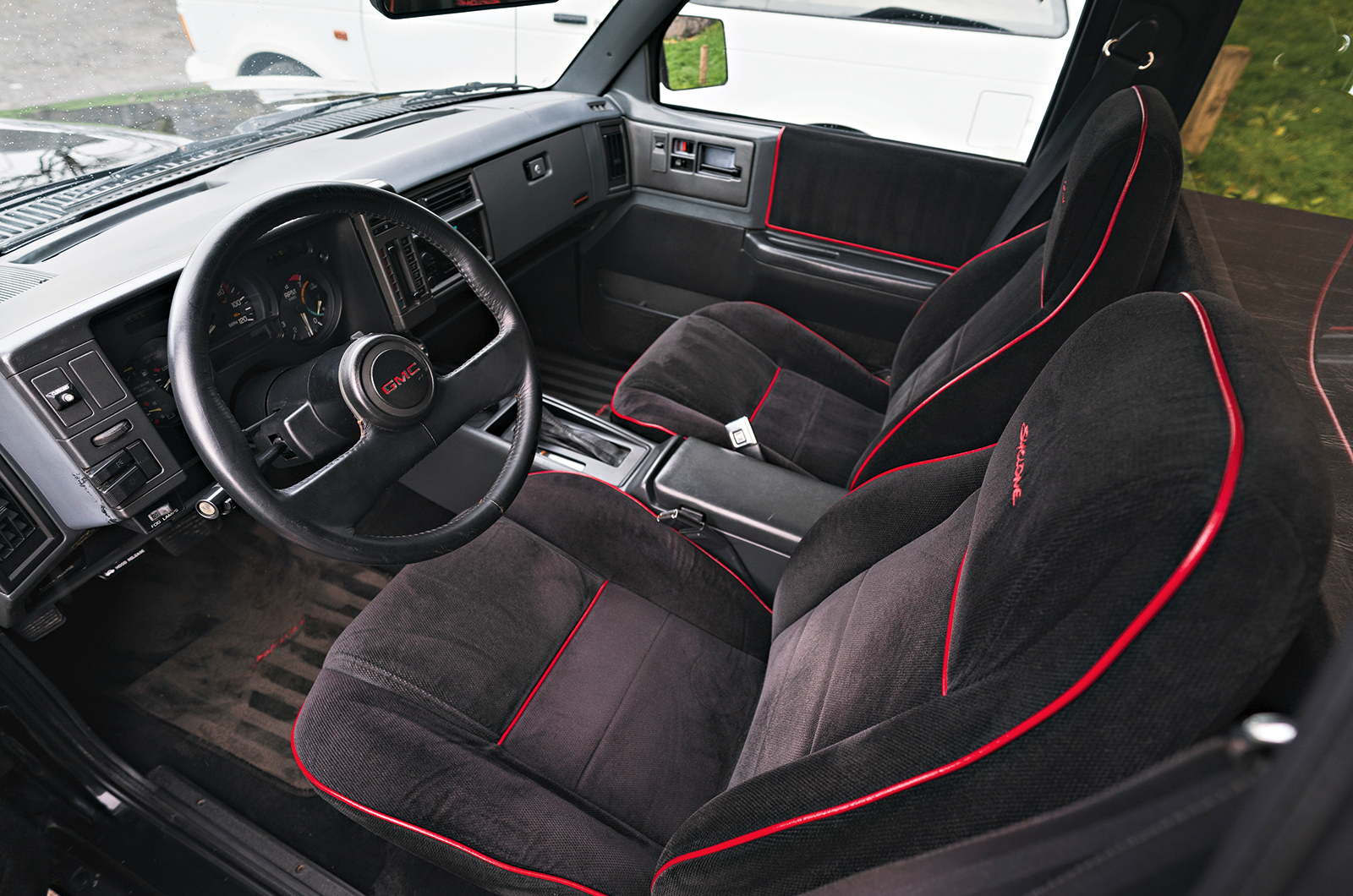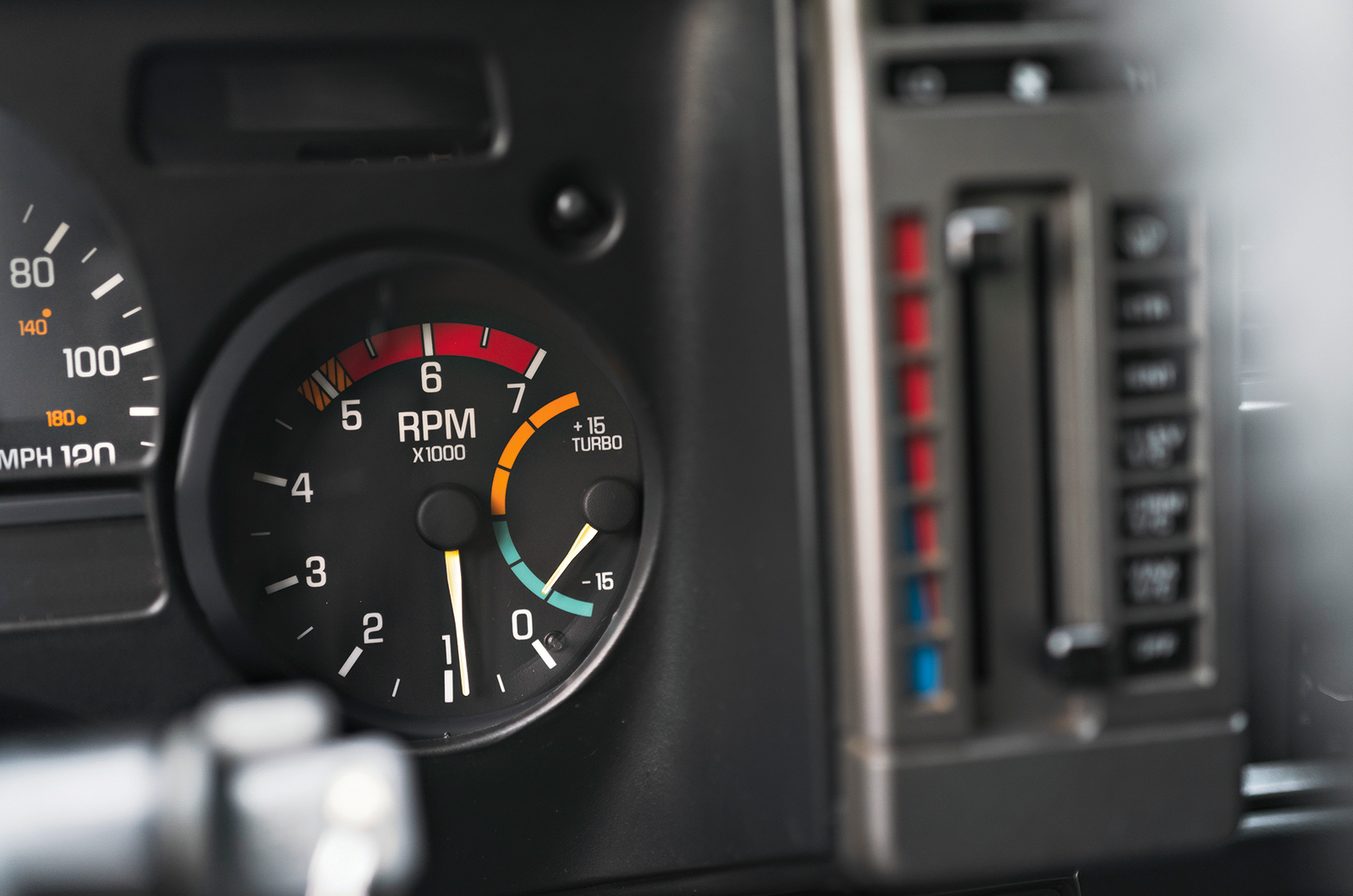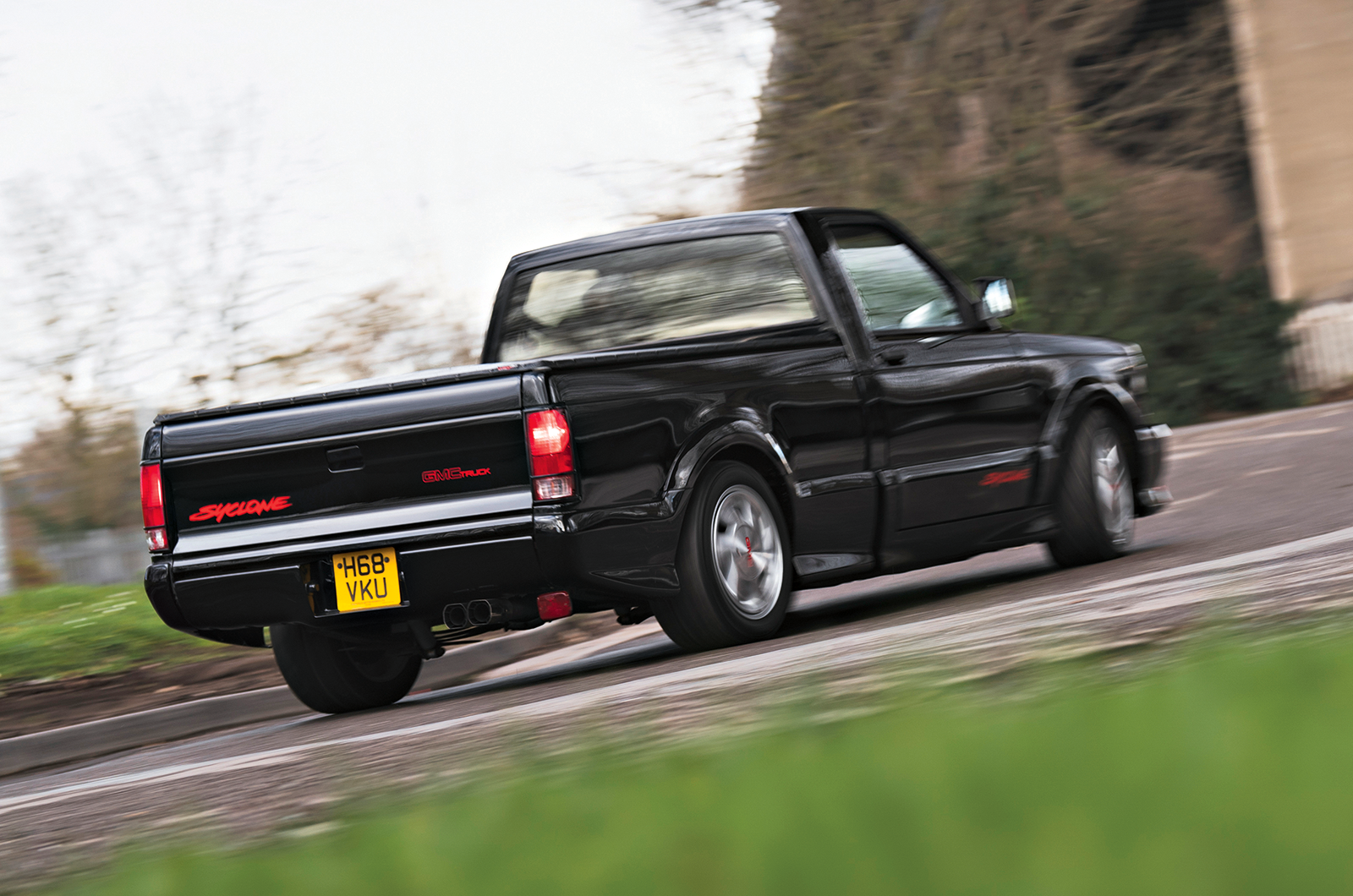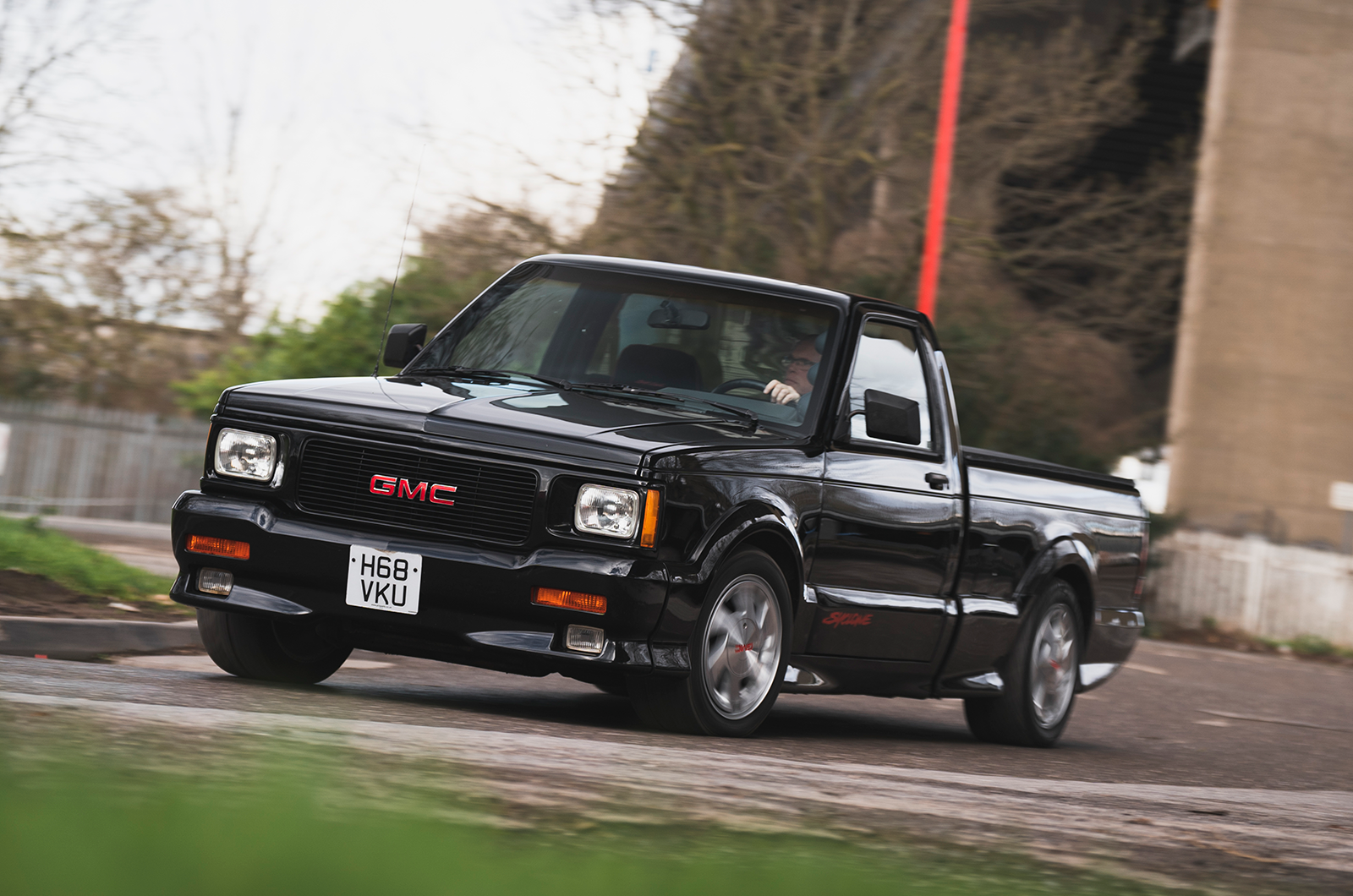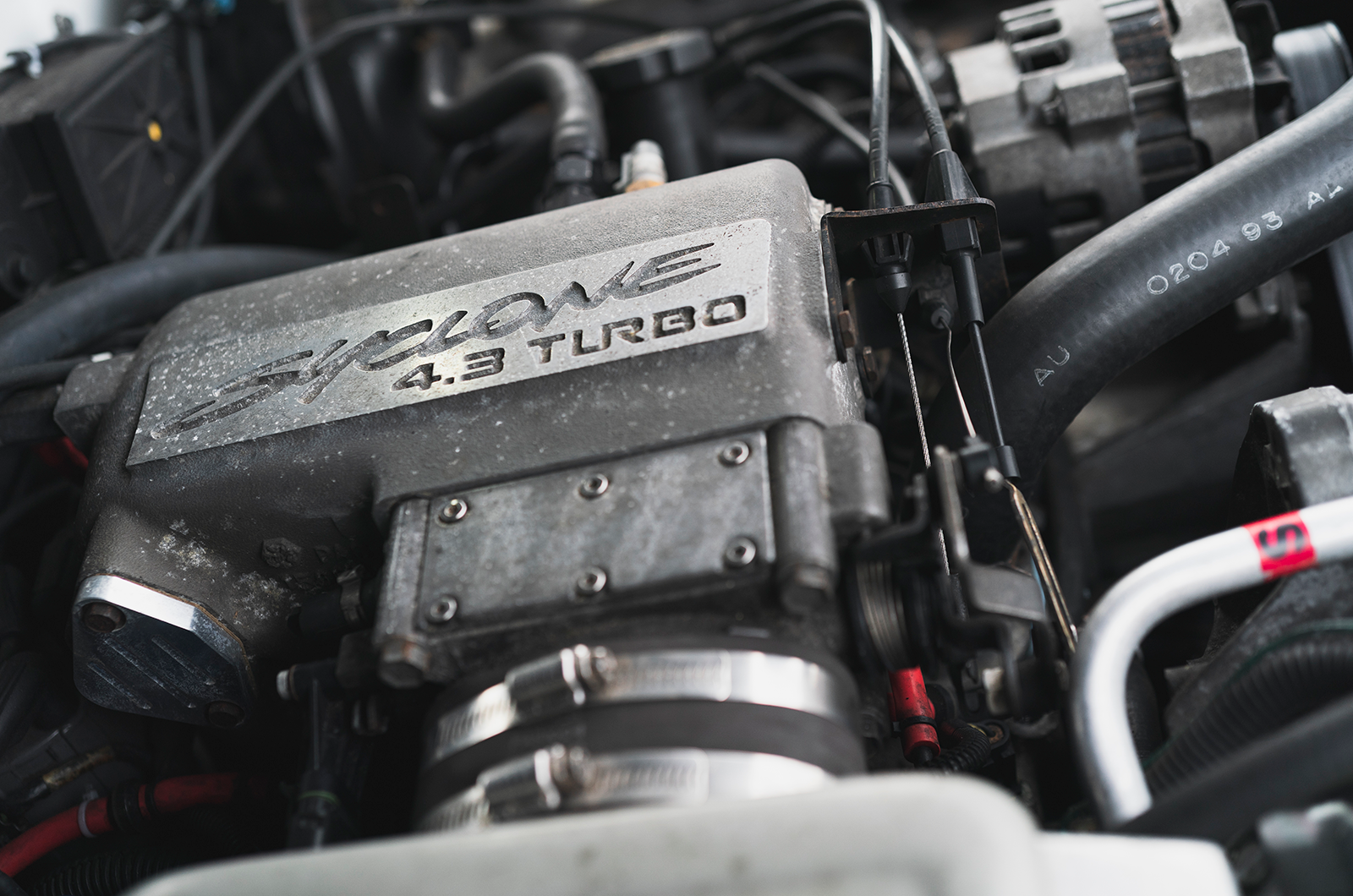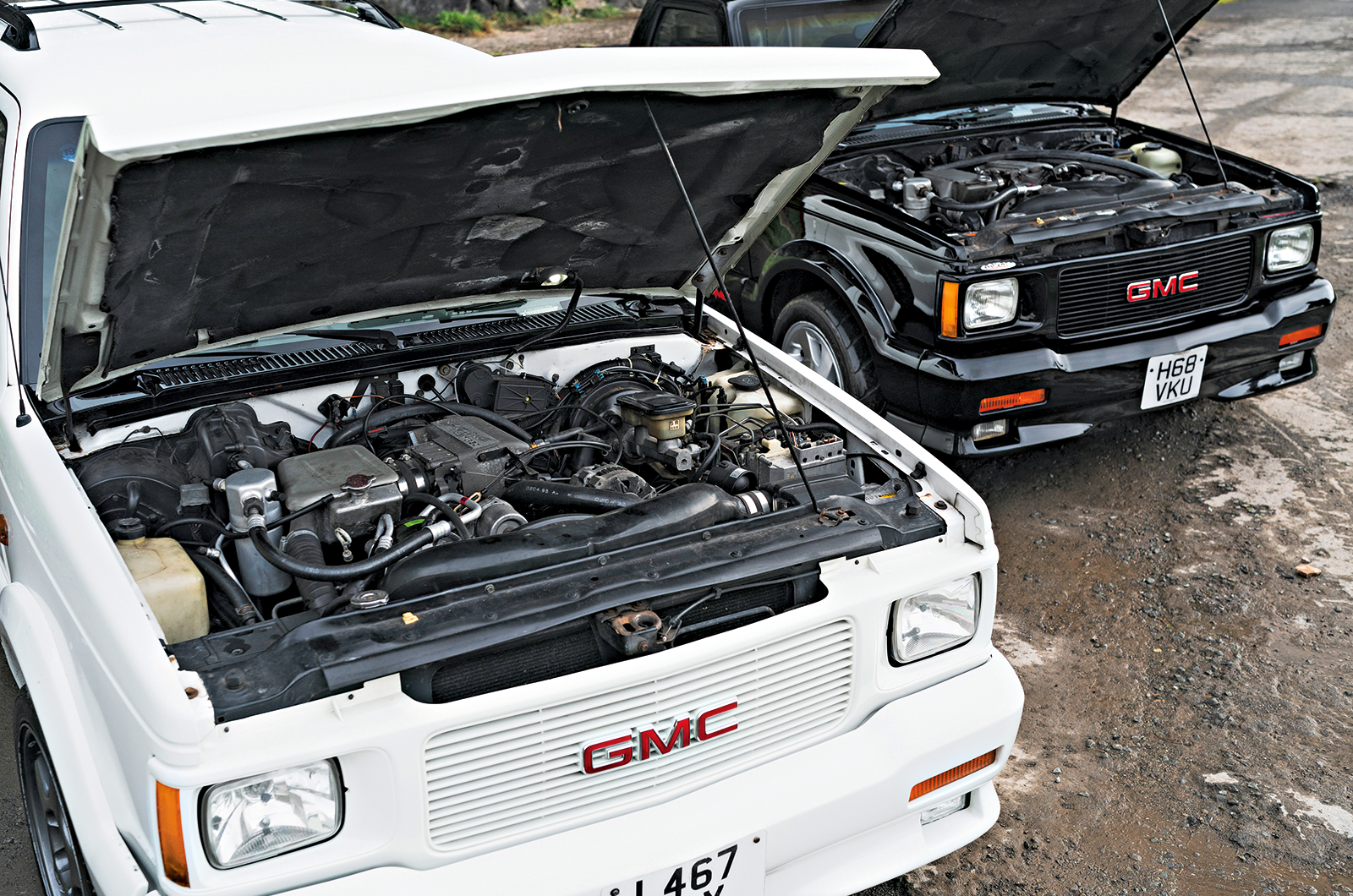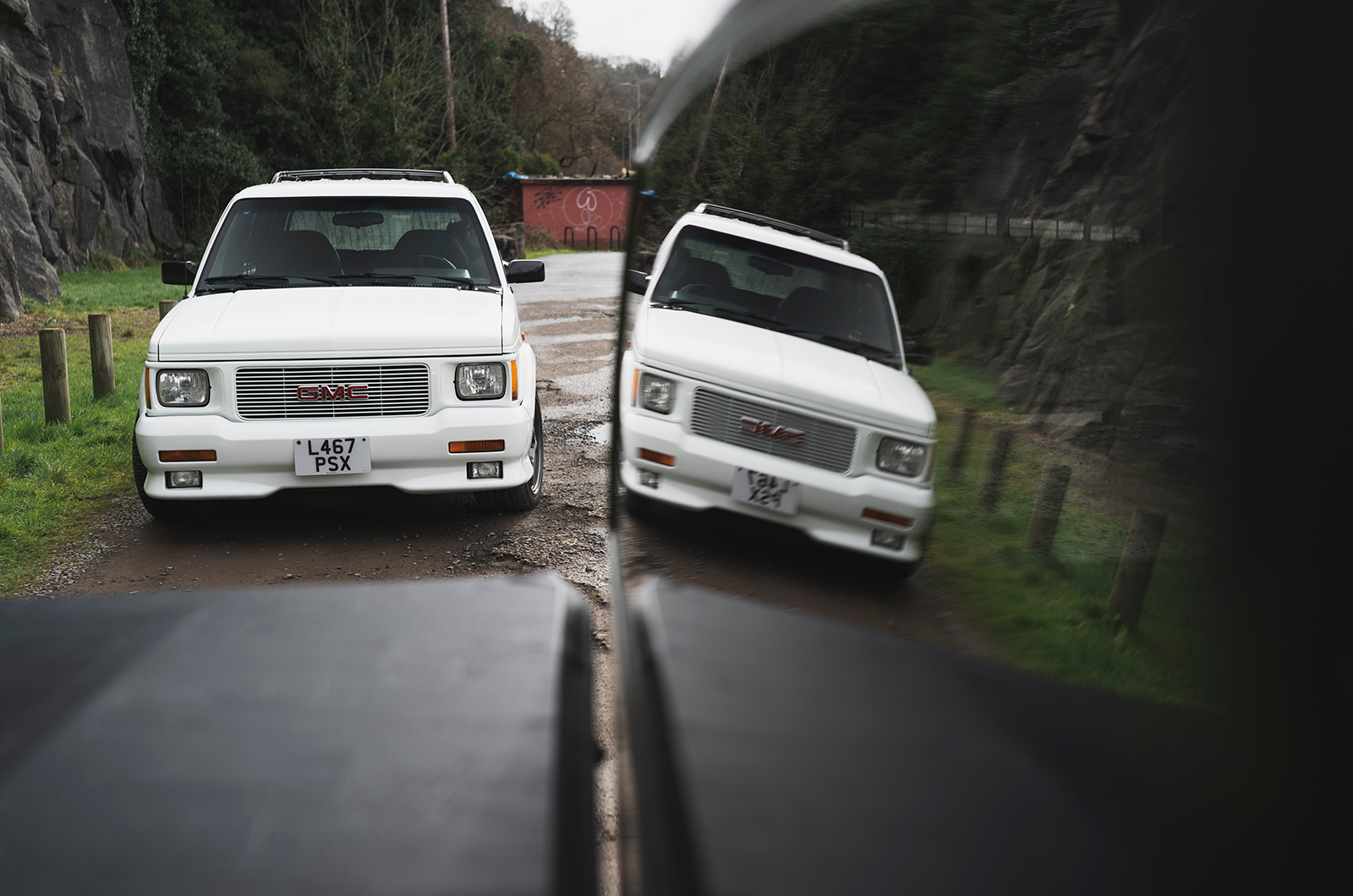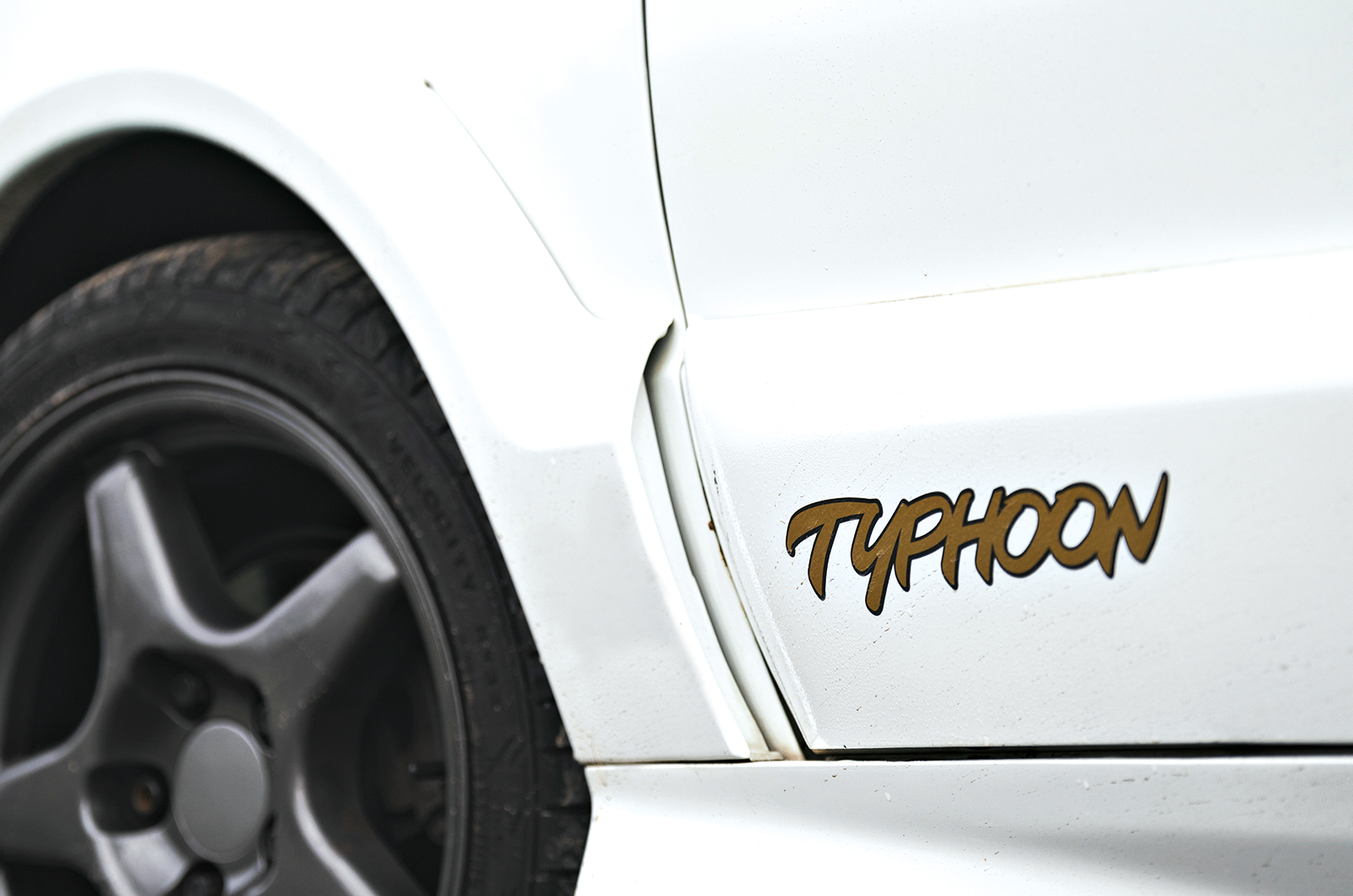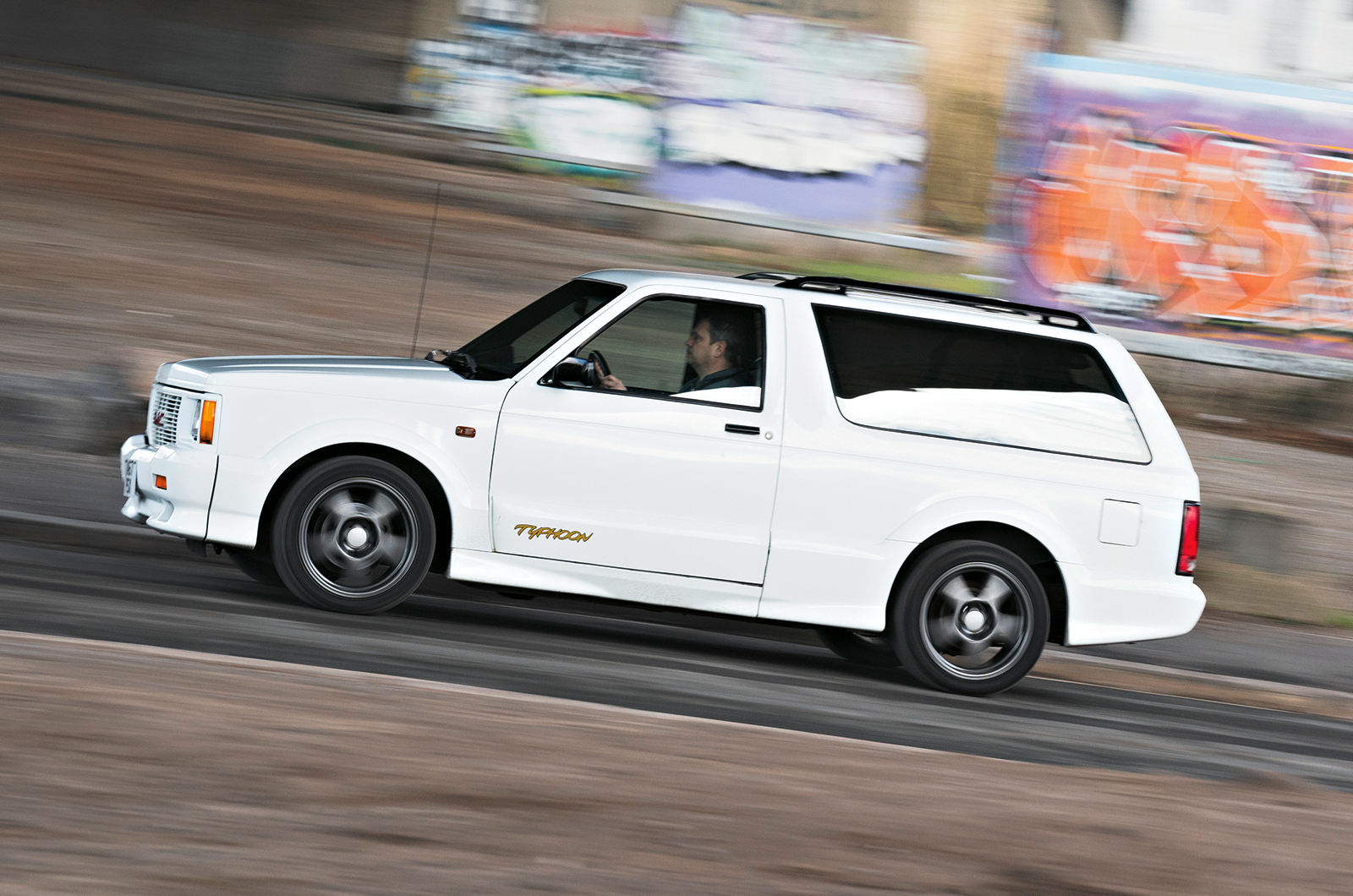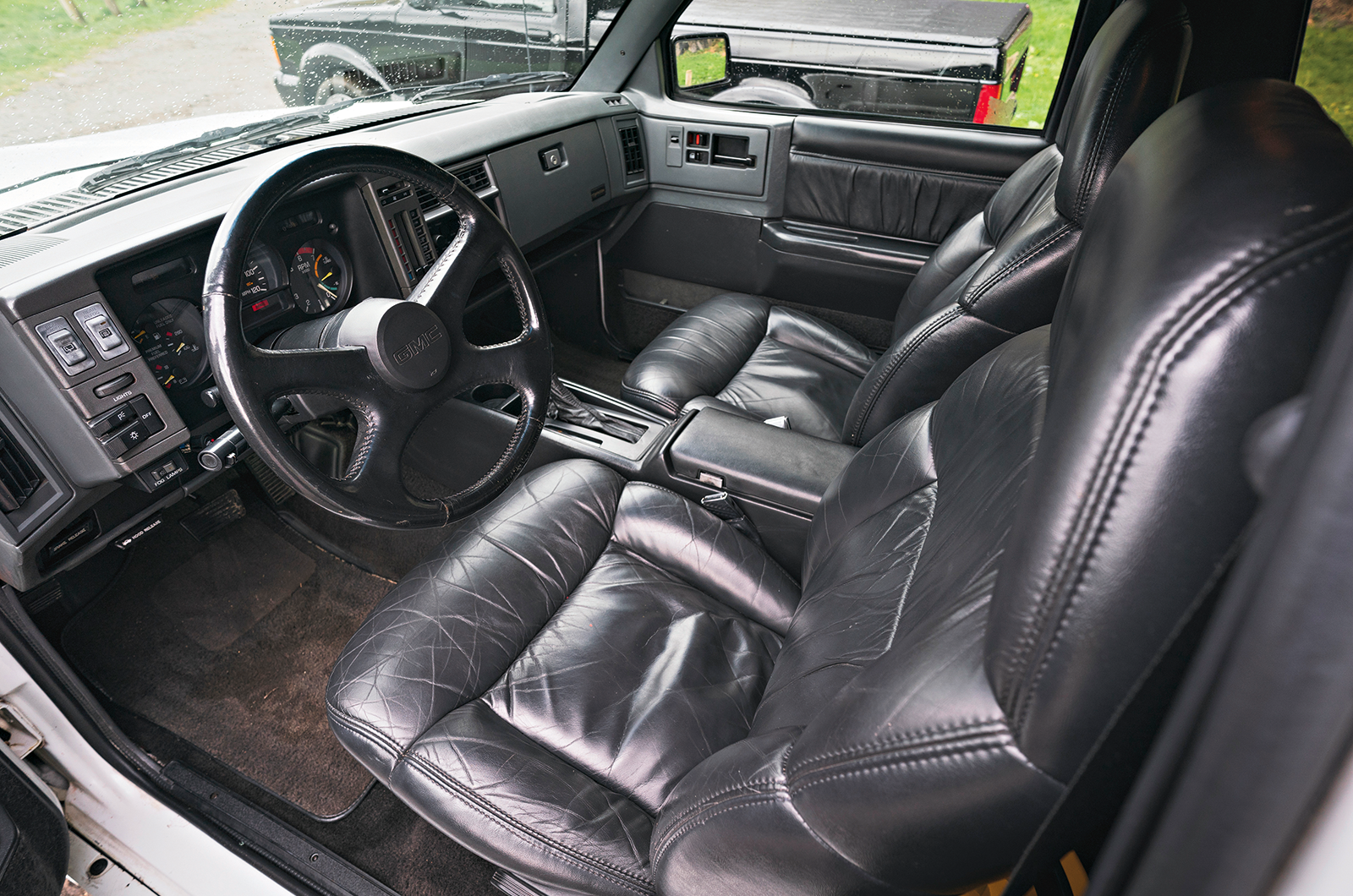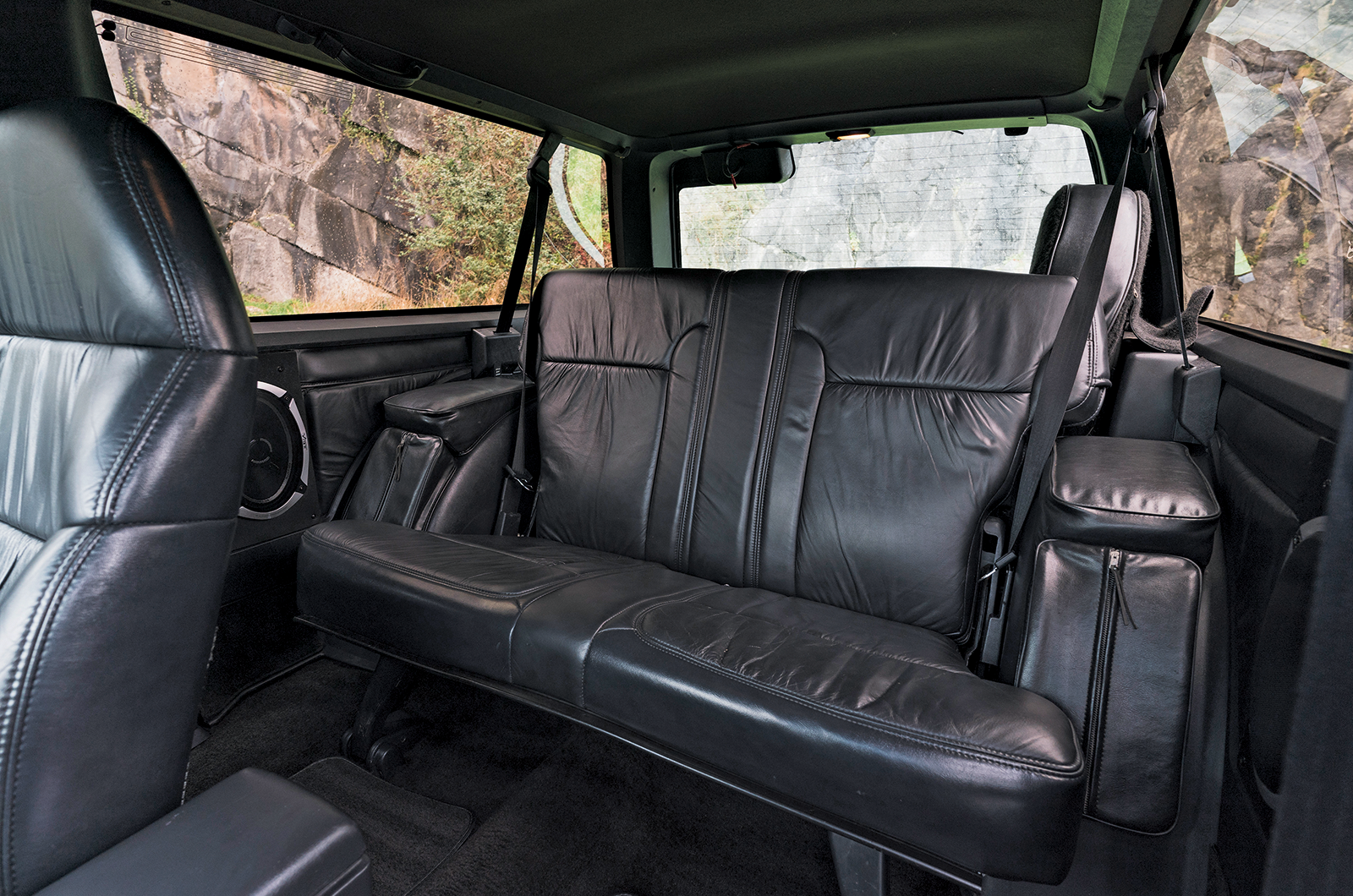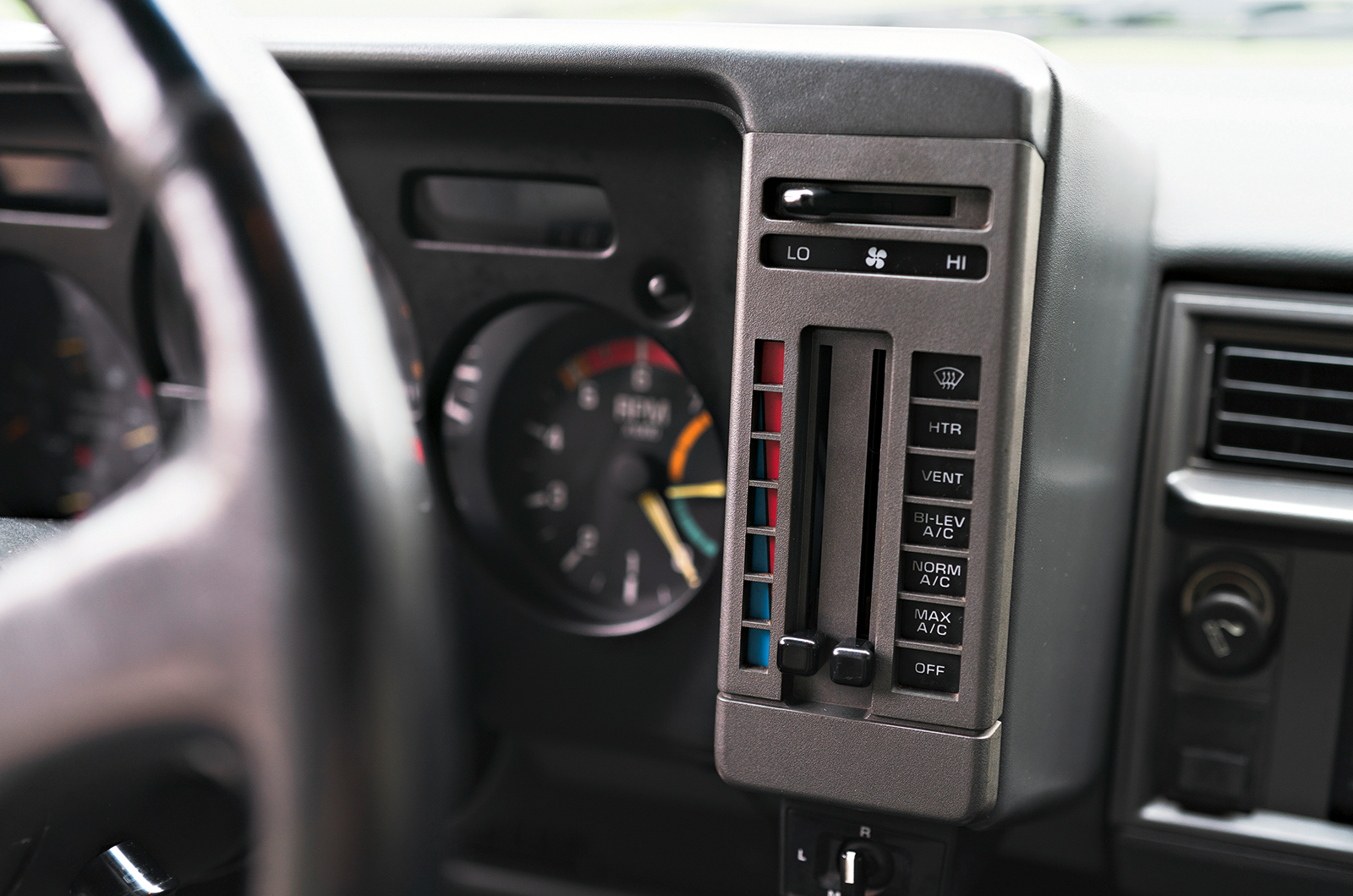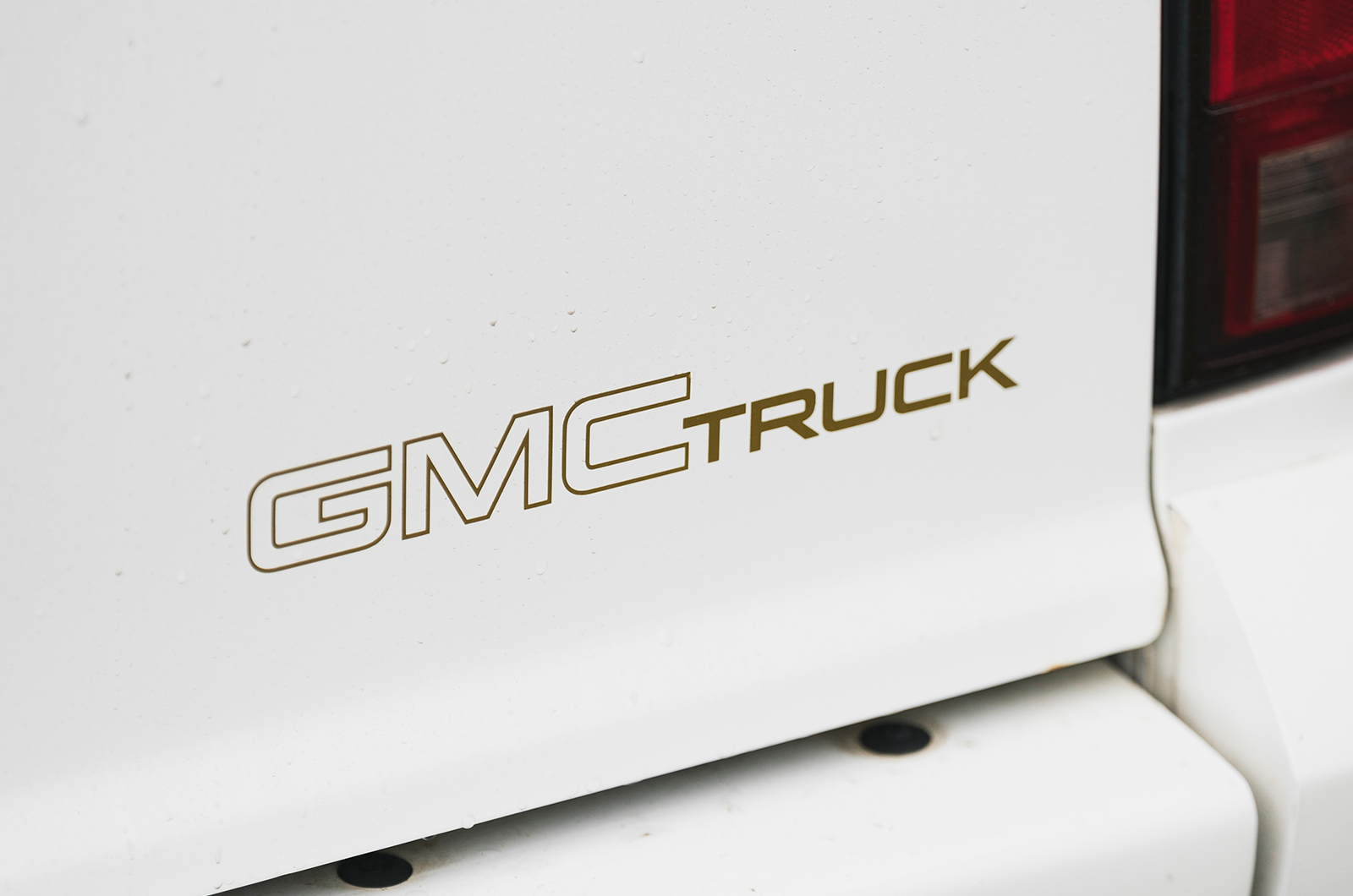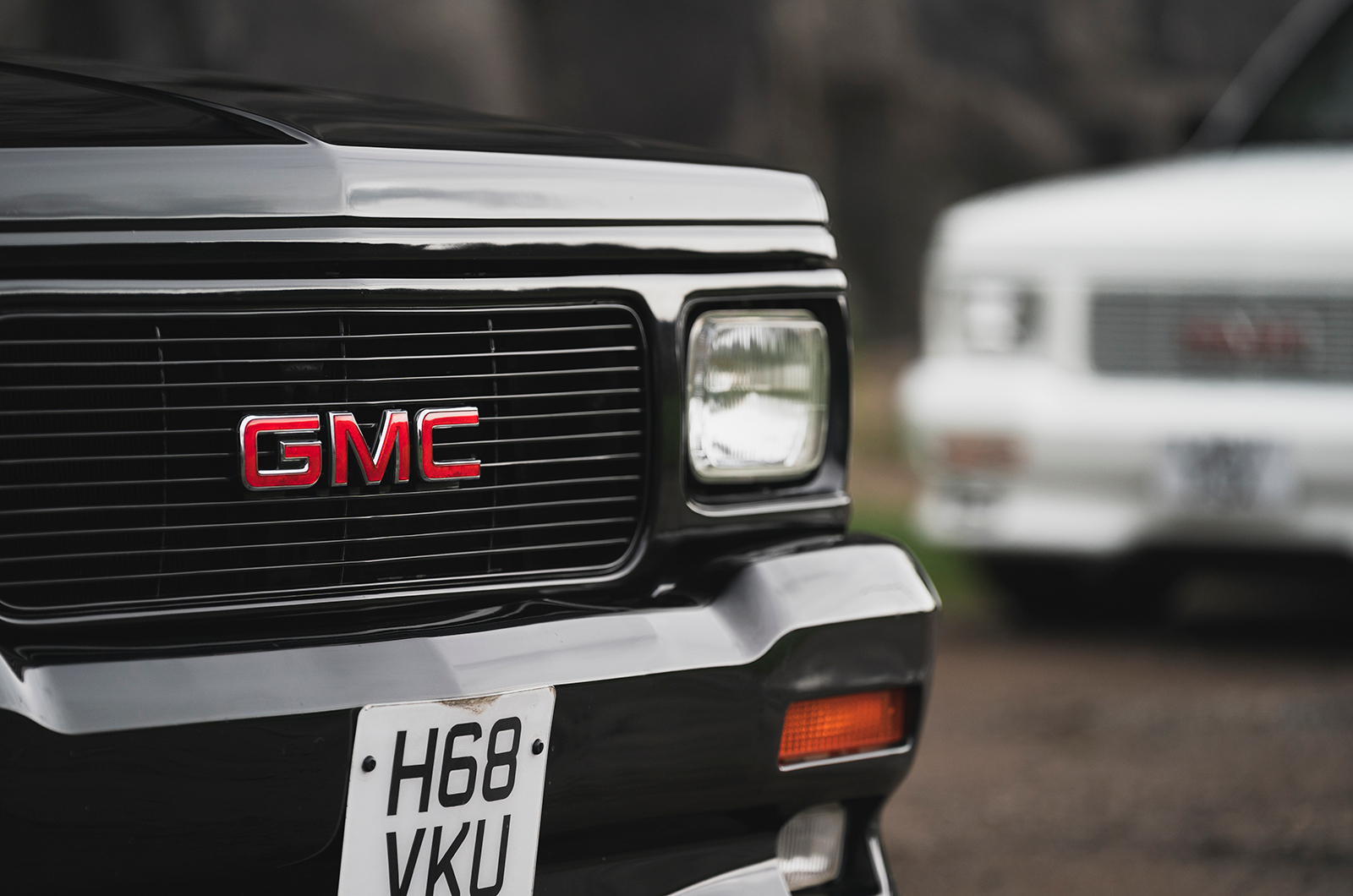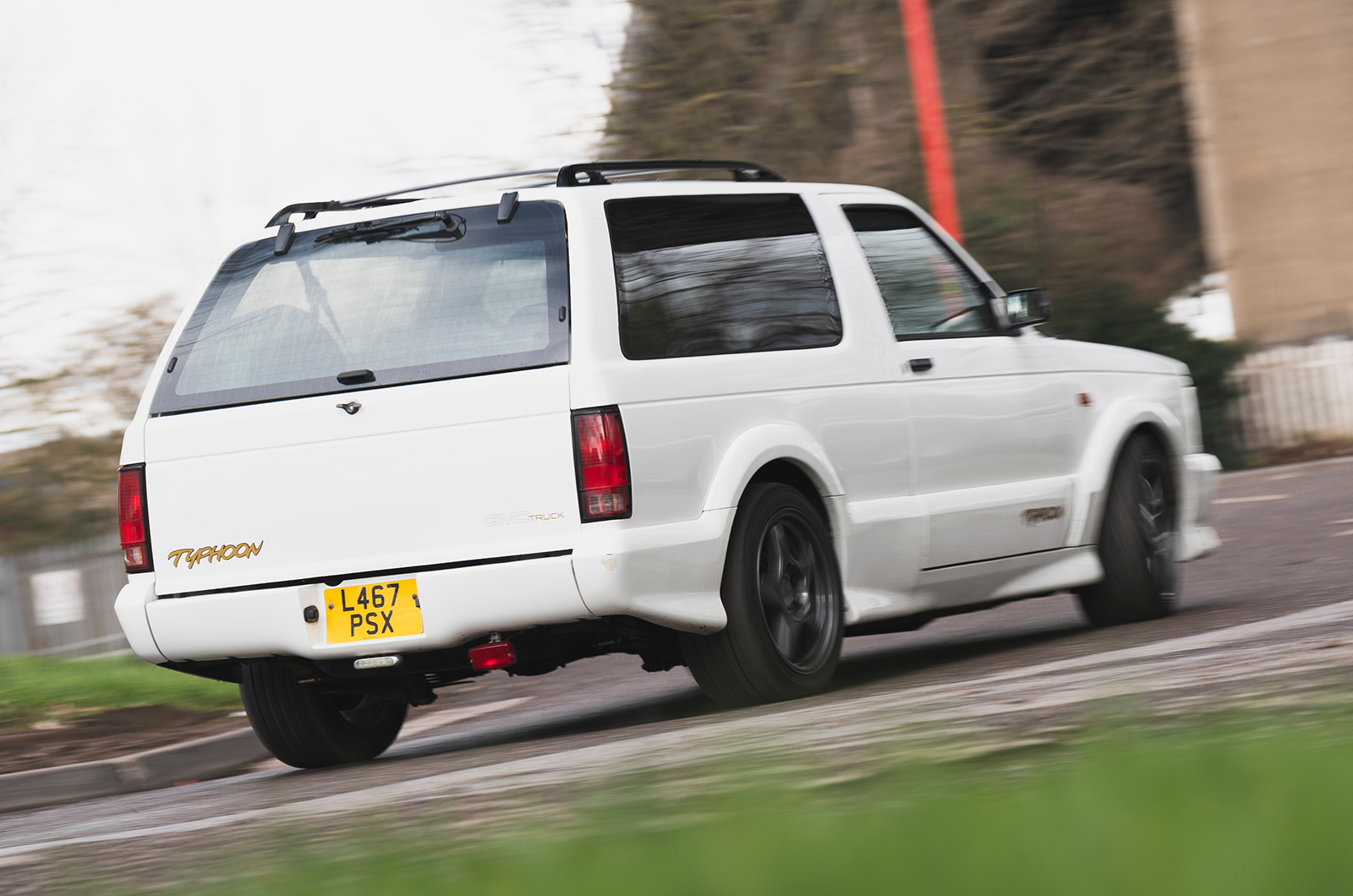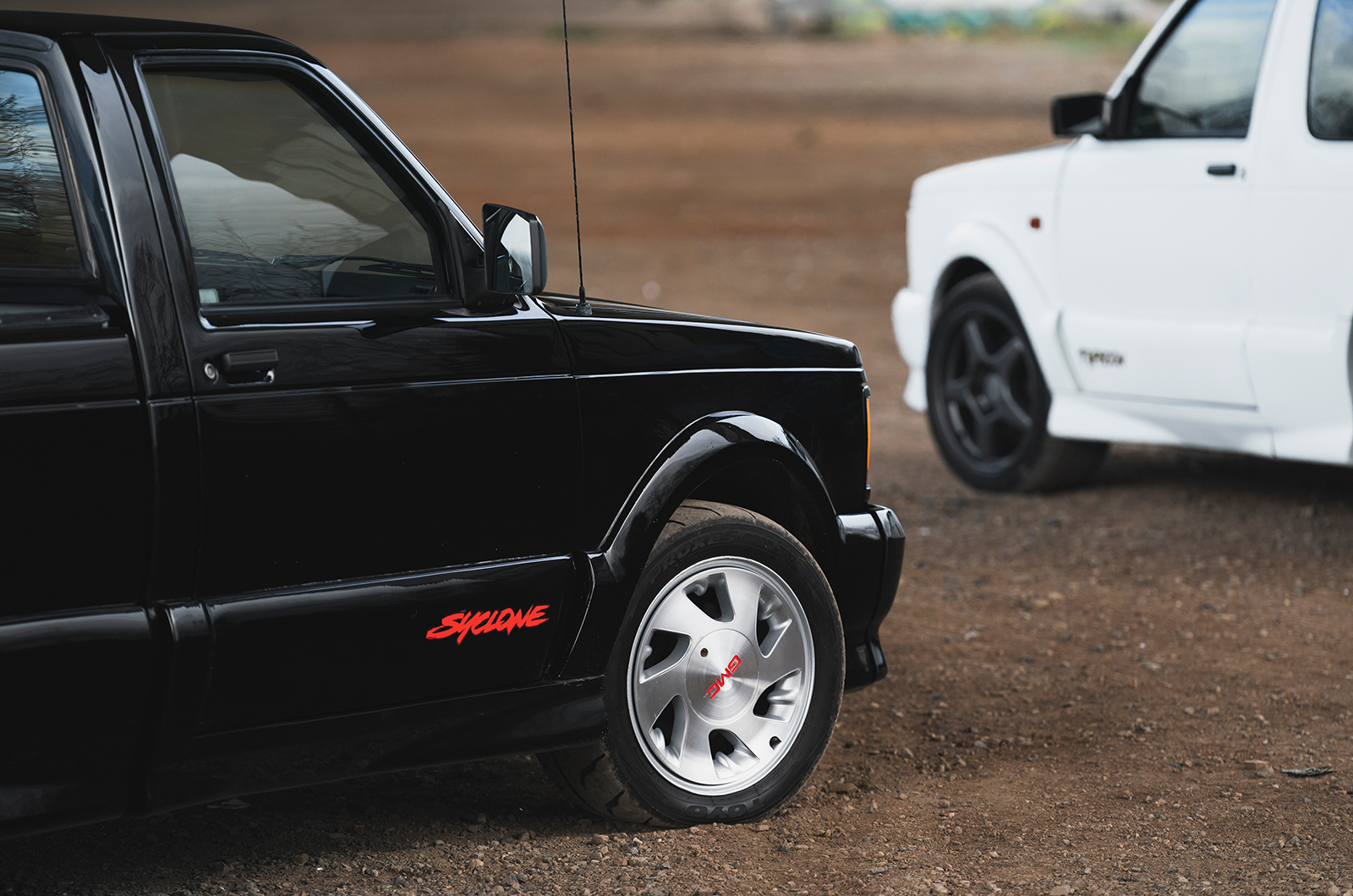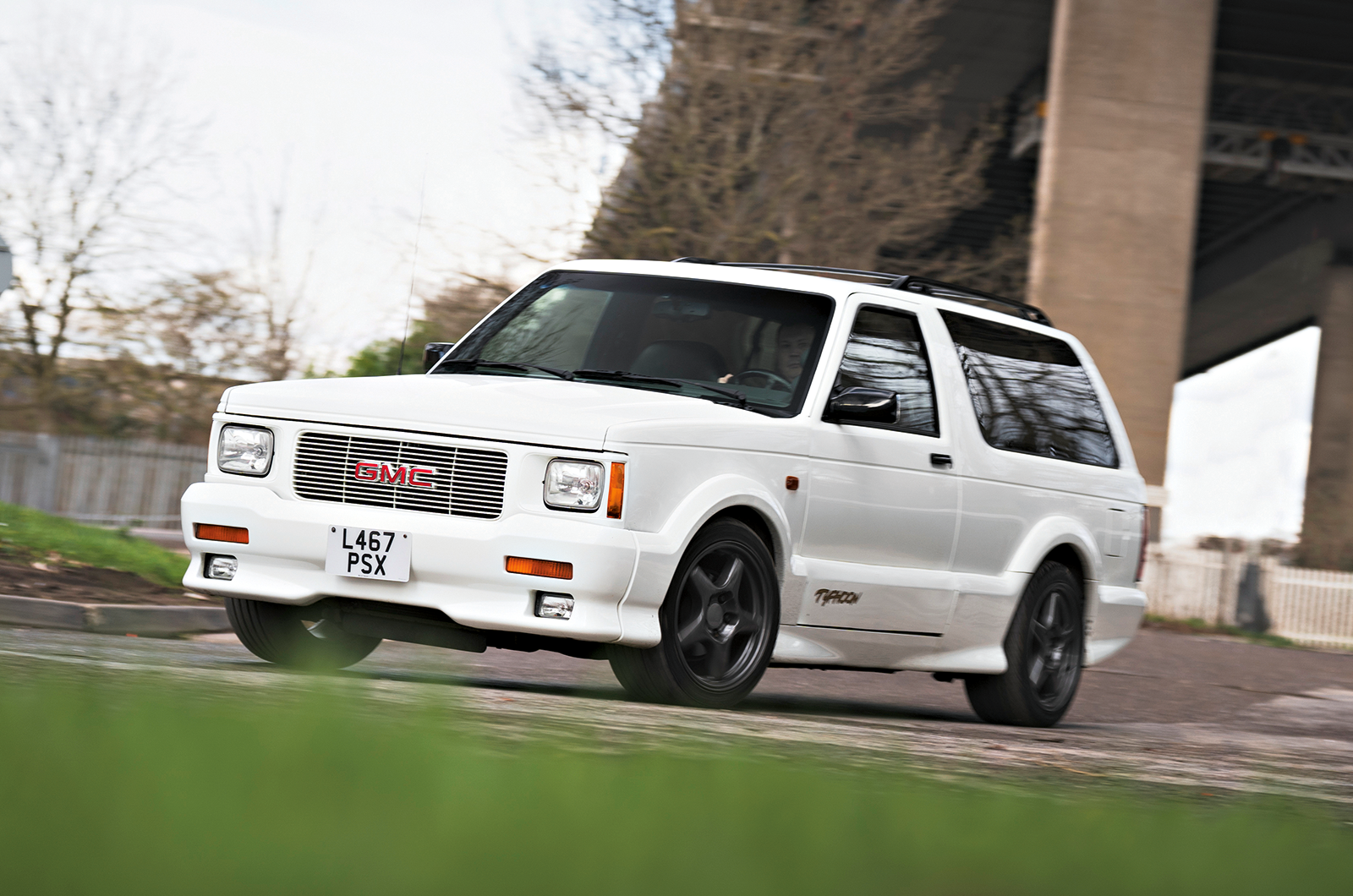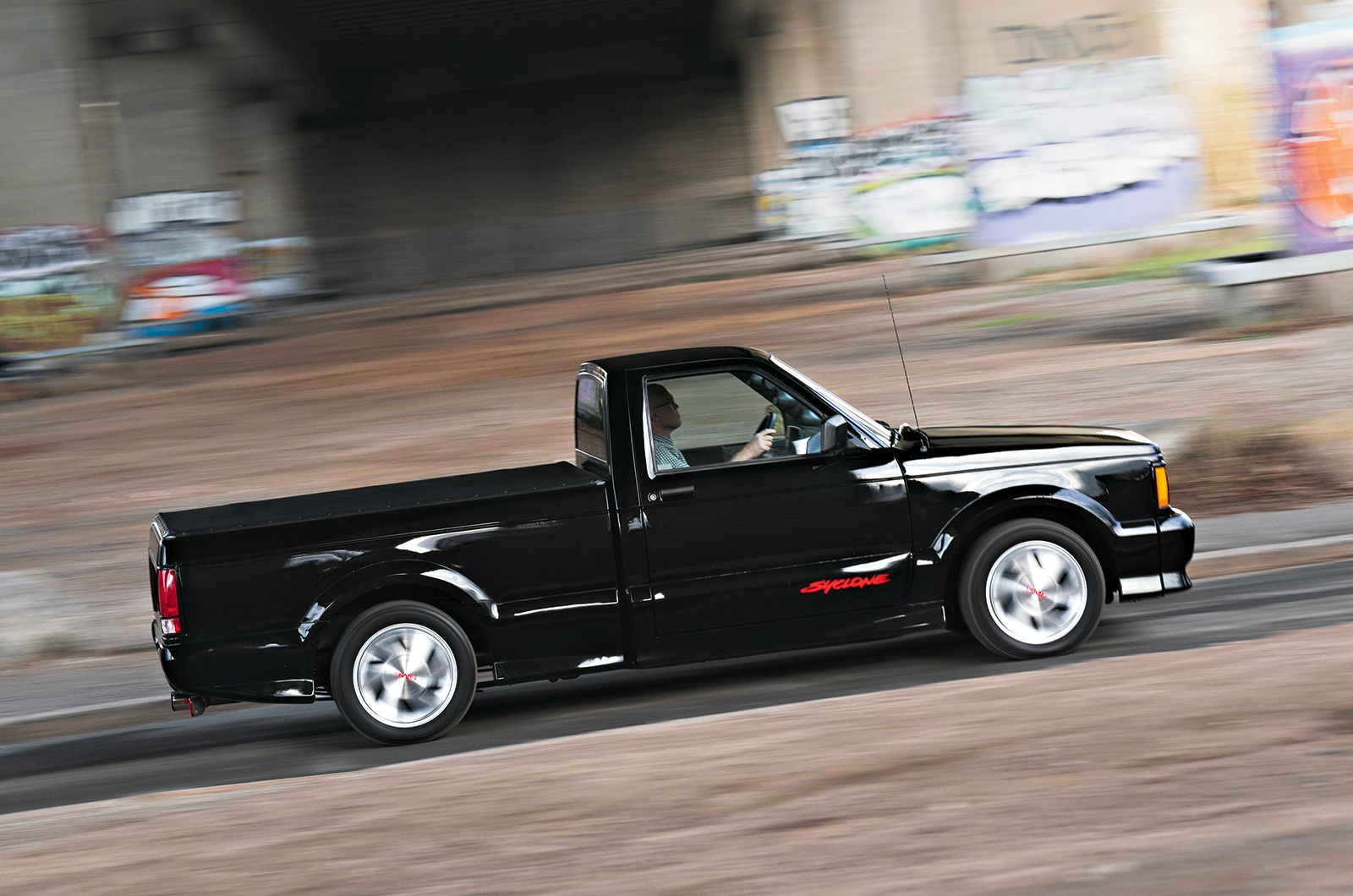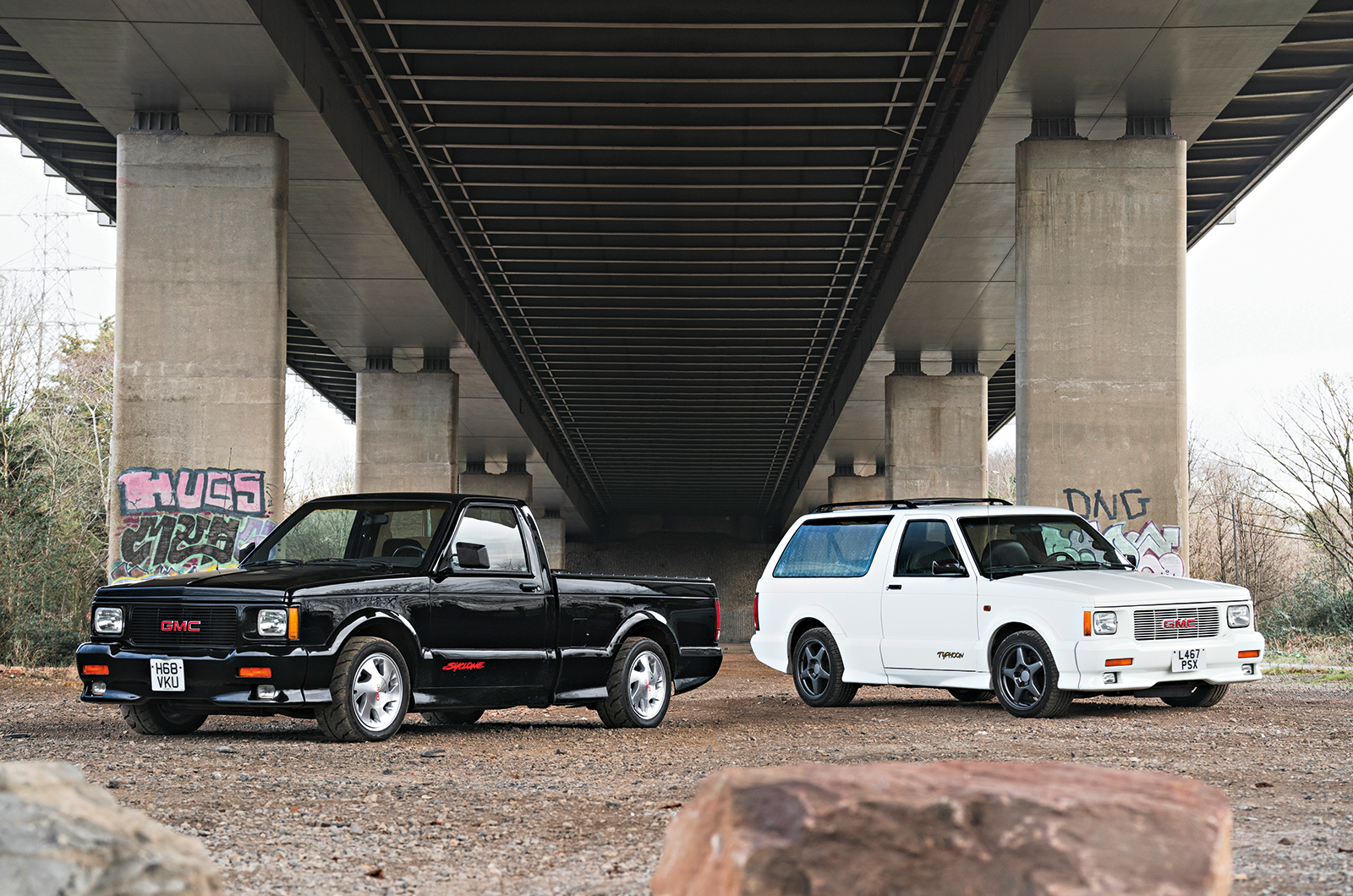But GMC evidently wished to amortise its investment costs with PAS still further, so in 1992 the company turned its second ‘concept truck’ into a production reality.
The Typhoon, based on the aforementioned GMC Jimmy/Chevrolet Blazer, was essentially a Syclone from the B-pillars forward and used the same PAS-developed powertrain.
But while a Syclone was something of a one-trick pony, the Typhoon was a fully fledged carrier of four people, with sumptuous leather trim and a full exterior colour range, while sacrificing very little in outright performance (0-60mph was up by just 0.7 secs to 5.3).
The 223lb-lighter Syclone (left) is faster to 60mph by 0.7 secs
Weighing in at 3822lb – 223lb more than the Syclone – the Typhoon introduced an 8in-shorter, 100.5in wheelbase, making it more manoeuvrable around town and, in theory, a more alert handler.
It also gained an electronic load-levelling system, meaning a 900lb payload – ironically 400lb up on that of the pick-up-bodied Syclone.
The white example keeping the Syclone company today is also owned by Marcus.
Exported to Japan early in its life (only 84 Typhoons were exported from new, all of which were destined for Saudi Arabia), it still wears non-standard turn signals on its wings and a black scuttle panel that should be body-coloured.
A shorter wheelbase makes the Typhoon more manoeuvrable around town
Inside, other than some minor control redesigns, a four-spoke steering wheel and internally adjustable door mirrors, the Typhoon’s front cabin is much the same as that of the Syclone.
But occupants over six-feet tall would have had the luxury of a few more inches of seat travel instead of hitting a bulkhead.
Being a two-door body, entry to the rear is a little compromised and, thanks to the leather-trimmed storage bins at either end of the bench, there’s only room for two passengers.
But that added usability clearly boosted the go-faster GMC’s appeal, with 4697 sold during its 1992-’93 production years, an increase of more than 50% over the Syclone.
‘The concept was initially rejected, but when GMC got wind of the project it immediately saw potential’
Drive the Typhoon straight after its pick-up sibling and you feel the extra bulk playing its part.
It’s still hot-rod quick, but lacks the outright lairiness of the Syclone.
There’s less aural drama, too, perhaps thanks to its generously insulated rear cabin.
But one characteristic instantly stands out versus driving the Syclone, and it tells a far bigger story about GMC outsourcing both vehicles’ development.
The Typhoon better fulfils its aesthetic brief
At almost any speed in Marcus’ Typhoon, engine vibration fizzes through all control surfaces, as if a vital filter is missing. Which it is.
When the rubber engine mounts disintegrated, rather than replace them – which is an engine-out task – Marcus opted to do without them completely, leaving the engine solid-mounted to the chassis.
As he explains, the lightning-quick PAS turnaround of the Syclone/Typhoon programme left little time for thorough development, which would have exposed the effects of significantly increased heat-soak – as well as additional torque stress – from the turbo’s installation in the engine bay, in turn causing accelerated wear of the rubber mounts.
In other words, replacing the bushes would become an ongoing major task, and one that you can’t blame him for wanting to avoid.
Wheelspin is notable by its absence in the Syclone, despite the potent performance, and it rides well over broken surfaces
It would be easy to part company with these hooligan trucks having had your view tainted by some flawed chassis dynamics and a lack of development that would contribute to issues further down the line.
But they should be celebrated, partly because their existence showed that get-the-job-done pragmatism was alive and well, even in a global conglomerate, and more importantly, they demonstrated that GM suits were still brave enough to enliven one of their brands with such a radical – yet not hugely profitable – model.
Images: Luc Lacey
Thanks to: Marcus Hawker and Mark Edwards
Factfiles
GMC Syclone
- Sold/number built 1991/2995
- Construction steel body, separate steel chassis
- Engine all-iron, ohv 4300cc V6, with turbocharger, intercooler and multi-point fuel injection
- Max power 280bhp @ 4200rpm
- Max torque 350lb ft @ 3600rpm
- Transmission four-speed automatic, 4WD
- Suspension: front independent, by wishbones, torsion bars, anti-roll bar rear live axle, semi-elliptic leaf springs; telescopic dampers f/r
- Steering power-assisted recirculating ball
- Brakes discs front, drums rear
- Length 15ft ½in (4585mm)
- Width 5ft 4¾in (1646mm)
- Height 5ft 1¼in (1557mm)
- Wheelbase 9ft ¼in (2751mm)
- Weight 3599lb (1632kg)
- 0-60mph 4.6 secs
- Top speed 124mph
- Mpg 14
- Price new $25,970
- Price now £15-25,000*
GMC Typhoon
- Sold/number built 1992-‘93/4697
- Construction steel body, separate steel chassis
- Engine all-iron, ohv 4300cc V6, with turbocharger, intercooler and multi-point fuel injection
- Max power 280bhp @ 4200rpm
- Max torque 350lb ft @ 3600rpm
- Transmission four-speed automatic, 4WD
- Suspension: front independent, by wishbones, torsion bars, anti-roll bar rear live axle, semi-elliptic leaf springs; telescopic dampers f/r
- Steering power-assisted recirculating ball
- Brakes discs front, drums rear
- Length 14ft 2¼in (4674mm)
- Width 5ft 4¾in (1646mm)
- Height 5ft (1524mm)
- Wheelbase 8ft 4½in (2552mm)
- Weight 3822lb (1734kg)
- 0-60mph 5.3 secs
- Top speed 126mph
- Mpg 14
- Price new $29,530
- Price now £12-18,000*
*Prices correct at date of original publication
Enjoy more of the world’s best classic car content every month when you subscribe to C&SC – get our latest deals here
READ MORE
Heuliez Intruder: living the high life
Jeep Cherokee 4.0 Limited vs Range Rover 3.9 SE: Uncle Sam fights back
Luxury on the farm: Range Rover vs Mercedes G-Wagen
Simon Hucknall
Simon Hucknall is a senior contributor to Classic & Sports Car
